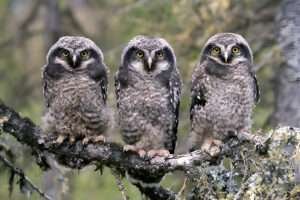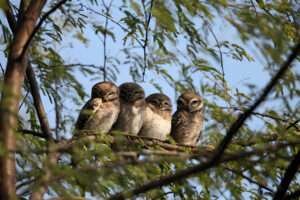A group of owls is called a parliament. This term reflects their perceived wisdom in folklore.
Delving into the avian world, the term “parliament” conjures up images of dignified owls gathered together, much like legislators in session. This peculiar and fitting name for a group of owls stems from their association with wisdom and knowledge, traits that are historically attributed to these nocturnal birds of prey.
Owls have captivated human imagination for centuries, often depicted in literature and mythology as sage creatures. Their silent flight, haunting calls, and piercing eyes make them fascinating and mysterious to bird enthusiasts and casual observers alike. Understanding these creatures better starts with knowing the basics, like their unique group name, which adds to the allure surrounding their enigmatic presence in the natural world.
Introduction To Owl Group Terminology
Understanding what a group of owls is called can be quite intriguing. This unique group name holds cultural and traditional significance, reflecting the mysterious aura surrounding these nocturnal birds. Let’s explore why these names are important and the cultural backdrop of owls in various societies.

Why Unique Names Matter
Unique names for groups of animals often tell a story. For owls, the term used is “a parliament.” This reflects historical views of owls as wise and dignified, similar to a group of lawmakers. Such names enhance our understanding of how different cultures view these creatures through anthropomorphic traits.
Cultural Significance Of Owls
Owls hold a special place in many cultures. They are often seen as symbols of wisdom and guardianship. This section lists how different societies perceive owls:
- Greece: Associated with Athena, goddess of wisdom.
- Native American: Considered protectors against evil spirits.
- India: Linked to wealth and prosperity.
These beliefs influence the names and stories we associate with owls.
The Etymology Of ‘parliament’
Did you know a group of owls is called a ‘Parliament’? This intriguing term has a fascinating origin story. Let’s delve into the etymology and compare it with other animal group names.
Historical Roots
‘Parliament’ comes from the Latin ‘parliamentum’, a discussion or debate. Owls are often seen as wise, which could be why we call a group of them a ‘Parliament’. They look like they are in a serious debate!
Comparison With Other Animal Group Names
Animal group names can be quite unique. Let’s compare a few:
- Lions: A pride
- Crows: A murder
- Fish: A school
- Elephants: A herd
Each name tells a story about the animal. Like ‘Parliament, they often reflect how we view these creatures.
Insights Into Owl Behavior
Ever wondered about the secret lives of owls in the wild? These mysterious birds have a unique social dynamic. Understanding their group interactions offers a fascinating glimpse into their world. Let’s dive into the world of owls and discover what a group of these nocturnal creatures is called and how they behave together.
Social Structure
Owls are often seen as solitary, but they can form groups. A group of owls is called a parliament. This term reflects their wise and regal demeanour, much like a gathering of dignitaries.
- Breeding pairs stick together during nesting season.
- Young owls may stay with their parents before venturing out.
- Some species display communal roosting for warmth and safety.
Common Behaviors In Groups
Owls exhibit fascinating behaviours in a parliament. These behaviours are not random but have specific purposes within their society.
| Behaviour | Purpose |
|---|---|
| Hooting | Communication and territory establishment |
| Preening | Bonding and social grooming among members |
| Hunting | Often a solitary activity, but can be coordinated |
Observing these behaviours in the wild reveals much about owl society. Each movement holds significance, whether in flight, at rest, or during interaction.
Owl Species And Group Dynamics
Ever wonder about owls’ social habits? These mysterious birds have intrigued us for centuries. Yet, not all owls hoot the same tune regarding the company. Some prefer solitude, while others enjoy a more communal roost. Let’s explore the different owl species and how they interact in groups.
Species Known To Form Groups
Diverse owl species exhibit various social structures. Discover which ones are known to flock together.
- Burrowing Owls: These ground-dwellers often live in colonies.
- Little Owls: They may roost in small family groups post-breeding.
- Snowy Owls: During harsh winters, they might form loose aggregations.
Lone Vs. Social Species
Not all owls seek the company of others. Here’s a glimpse at solitary and social owls.
| Solitary Owls | Social Owls |
|---|---|
| Great Horned Owls | Burrowing Owls |
| Barn Owls | Little Owls |
| Screech Owls | Snowy Owls |
In conclusion, while some owls, like Great Horned Owls and Barn Owls, often fly solo, others, such as Burrowing Owls, enjoy a more communal lifestyle. Owls’ social structures are as varied as their species.
Cultural Depictions Of Owls
Owls have long captured the human imagination. These mysterious birds appear in various cultures and traditions. They symbolize wisdom, mystery, or death. Their presence in art and stories tells of rich history and significance. Let’s explore the role of owls in folklore and the marks they’ve left on our language.
Owls In Folklore And Mythology
Owls hold a special place in folklore and mythology. Many cultures view them with awe and reverence. Here are a few ways they appear:
- Greek mythology: The owl symbolizes Athena, the goddess of wisdom.
- Native American lore: Owls are often seen as protectors against evil spirits.
- Japanese culture: Owls signify luck and protection from hardship.
Influence On Language And Names
The influence of owls extends beyond tales and into our language. Several phrases and names find their roots in these nocturnal creatures:
| Term | Origin | Meaning |
|---|---|---|
| “Wise as an owl” | Athena’s symbol | Associated with wisdom |
| “Night owl” | Owl’s nocturnal nature | Someone who stays up late |
| “Owlish” | Owl’s appearance | Describing a serious, thoughtful look |
Scientific Observations Of Owl Groups
The world of owls is fascinating and full of surprises. One particular interest of researchers is their social behaviour. A group of owls is called a parliament. This term reflects the owls’ wise and solemn standing in folklore. But what do scientists say about these mysterious gatherings?
Key Studies And Findings
Owl research has revealed unique insights into their group dynamics. While generally solitary, owls may form groups for breeding or in response to abundant food sources. Studies focus on various species and their group interactions.
- Observations of Snowy Owls show communal hunting during rodent surges.
- Burrowing Owls display cooperative vigilance in protecting their nests.
- Research on Forest Owls indicates mixed-species flocks during non-breeding seasons.
Impact Of Environment On Group Behavior
The environment plays a crucial role in owl group behaviour. Changes in habitat or prey availability can lead to variations in social structure.
| Environment | Behavioural Change |
|---|---|
| Abundant Prey | Temporary Groups Form |
| Scarce Resources | Solitary Behavior Dominates |
| Urban Areas | Increased Interactions |
Environmental pressures can lead to adaptive behaviours in owls, and researchers continue to explore how these birds adjust to changing conditions.
Conservation Efforts For Owls
When we explore the world of nocturnal wonders, we often marvel at owls’ wisdom and mystery. A group of owls is called a parliament, reflecting their dignified and collective nature. However, these majestic birds face many threats, and conservation efforts are vital to ensure their survival.
Threats To Owl Populations
Owls play a crucial role in our ecosystem. Despite this, they are in danger. Their challenges are diverse:
- Habitat loss due to deforestation and urban sprawl.
- Poisoning from rodenticides and pesticides.
- Climate change is altering their environments.
- Vehicle collisions on busy roads.
These issues require immediate action to protect owl populations.
Role Of Group Behavior In Conservation Strategies
Understanding the social structure of owls can aid in their protection. Parliaments of owls exhibit behaviours that conservationists can leverage:
| Behaviour | Conservation Strategy |
|---|---|
| Roosting | Create safe nesting sites. |
| Hunting | Ensure a healthy prey population. |
| Parenting | Protect areas during the breeding season. |
By promoting these natural group behaviours, we can enhance owl conservation efforts.
How To Spot An Owl Parliament
Many are fascinated by the nocturnal wisdom of owls. A group of owls is called a parliament. This term reflects their reputation for being wise. Spotting an owl parliament is thrilling for birdwatchers. Here is how to increase your chances of witnessing these magnificent birds in their natural gathering.
Tips For Birdwatchers
Research owl habits and calls before venturing out. Owls have unique behaviours and vocalizations that can help you locate them.
Move quietly and patiently through their habitat. Owls are sensitive to noise and may retreat if they detect your presence.
- Wear camouflage or neutral-coloured clothing to blend in with the environment.
- Use binoculars to spot owls from a distance without disturbing them.
- Bring a field guide to identify different species and understand their patterns.
Best Times And Locations
Owls are crepuscular, meaning they are most active during dawn and dusk. Plan your birdwatching during these times for the best chances of seeing an owl parliament.
| Time of Year | Location | Note |
|---|---|---|
| Spring and Fall | Woods and Forests | Mating and migration periods offer increased sightings. |
| Winter | Open Fields and Marshes | Owls hunt in these areas when trees are bare. |
| Summer | Near Water Sources | Owls frequent lakes and rivers for prey and cooling. |
Check local wildlife reserves and parks as they often provide habitat sanctuaries for owls. These protected areas are excellent spots to observe a parliament of owls in their natural setting.

Frequently Asked Questions
Why Is A Group Of Owls Called A Parliament?
A group of owls is called a parliament because of their perceived wisdom, echoing the term for a gathering of knowledgeable leaders. This analogy dates back to ancient folklore and was popularized by C. S. Lewis’s “The Chronicles of Narnia.
”
What Is A Group Of Woodpeckers Called?
A group of woodpeckers is commonly referred to as a “descent. ” This term captures the collective nature of these birds when they are seen together.
What Is A Group Of Ravens Called?
A group of ravens is commonly called an “unkindness” or a “conspiracy. ” These terms highlight the bird’s mysterious and often mischievous nature.
What Group Of Birds Is Called A Congress?
A group of owls is commonly referred to as a congress. This term highlights their collective wisdom and dignified presence.
Conclusion
Discovering the term “parliament” for a group of owls adds a whimsical layer to our understanding of these fascinating creatures. Embrace this nugget of knowledge and share it with fellow bird enthusiasts. It’s not just a quirky fact; it’s a testament to the unique nature of owls in the avian world.




